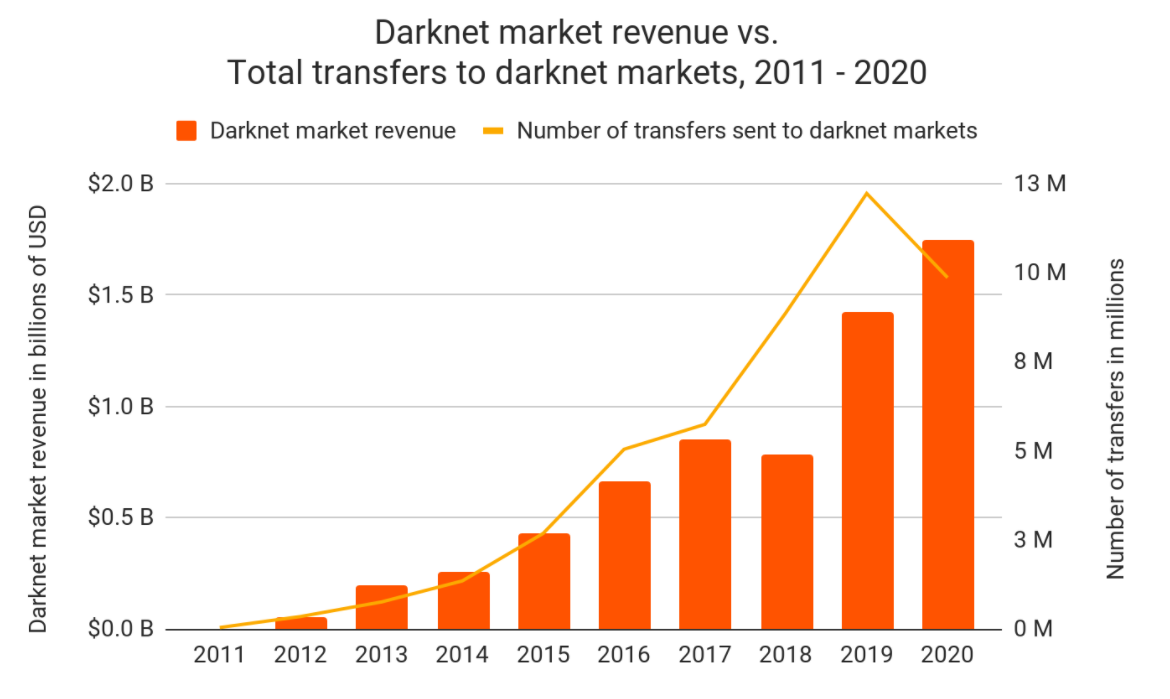As most of us know, 2020 was a year of polar opposites in the business world. Some businesses went bust while others boomed and set new records.
One profitable line of work during the pandemic? Selling illicit goods and services on the Dark Web.
These darknet markets hauled in a record amount of revenue last year, with customers around the globe spending $1.7 billion in cryptocurrency.
Chainalysis, which tracks this kind of spending, shared new research breaking down darknet markets and their geographic distinctions in 2020.
Dark Web markets: record spending in 2020
The chart below reveals darknet market revenue and the number of transfers to those markets. The gold line shows that the actual number of individual transfers dropped in 2020, but the orange bars show that 2020 was the first year for darknet market revenue to top $1.5 billion.

Hydra is the largest darknet market in the world, accounting for more than 75% of the total darknet market revenue in 2020, despite only serving Russian speakers.
"Hydra is a big driver of Eastern Europe's unique crypto crime landscape. Eastern Europe has one of the highest rates of cryptocurrency transaction volume associated with criminal activity and, thanks to Hydra, is the only region with a criminal service as one of the top ten entities sending cryptocurrency value to the region.
Hydra could eventually come to the English-speaking world as well. In December 2019, Hydra announced plans to raise $146M in an ICO for a new global DNM service called Eternos. While it appears Covid has put this plan on hold, the announcement makes it clear that Hydra plans to expand.
That could create a significant challenge for U.S. and European law enforcement, as Hydra has developed uniquely sophisticated operations, such as an Uber-like system for assigning drug deliveries to anonymous couriers, who drop off their packages in out-of-the-way, hidden public locations, commonly referred to as 'drops,' which are then shared with the buyers. That way, no physical exchange is made, and unlike with traditional darknet markets, vendors don't need to risk using the postal system."
What are the most popular things for sale on the darknet?
Interestingly enough, if you were to exclude Hydra and other darknet markets that serve a particular region, the darknet markets are much less concentrated with several different markets taking in significant revenue.
When looking at it this way, the largest markets are primarily drug shops and fraud shops, which you can see in Chainalysis' graph below. Fraud shops sell malware, stolen credit card numbers, compromised user accounts of many types, and some assist with money laundering.
Geography of darknet markets
When looking at transactional data from darknet markets around the world, the biggest darknet market consumers were from Eastern Europe, Northern and Western Europe, and North America.
Eastern Europe sends and receives the most value from darknet vendors because of Hydra, which is a major market outlier.
The report shows that the percentage of a region's share of drug-focused vendor activity matches very closely with what is known about the global drug trade. Generally, drugs are manufactured and grown in Latin American and Asia and consumed in North America and Western and Northern Europe. Which is what we see on the chart below.
Chainalysis also had this to say about the geography of darknet markets:
"The United States, Russia, Ukraine, and China dominate in terms of value both sent to and received from darknet markets. Venezuela and Vietnam also rank high on both sides, with their activity skewed slightly more toward darknet market buying, which could be related to the drug manufacturing activity prominent in both countries.
We also suspect that a good deal of China and Russia's volume received by darknet markets represents funds flowing to money laundering services concentrated in those countries, though it's possible similar services are operating in other countries receiving large volumes of funds from darknet markets."
For more information on darknet markets, you can read the full report by Chainalysis here.
